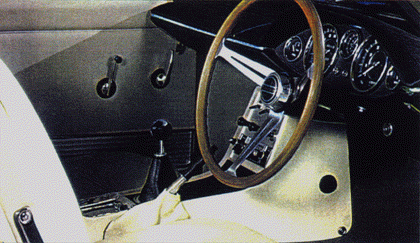The NISSAN Silvia - 1600 Sports Coupe



Albrecht Graf von Goertz;
Albrecht Graf von Goertz, a German Count by birth, emigrated to the United States of America at age of 22, just prior to WW-II. Two years after applying for his US Citizenship, he was drafted into the US Army in 1940 and discharged as a T/Sgt. in 1945. A chance meeting with Raymond Loewy set Mr. Goertz on the path to Industrial Design, a career he would pursue for a lifetime.
Mr. Goertz signed a contract for Design Consulting with Nissan Motors Ltd in Japan in 1963. He was first assigned to an existing Design Team headed by Mr. Kazuo Kumura that was working on the initial design of the Silvia Sports Coupe. Nissan Management was not satisfied with the initial design and Mr. Goertz made several detail changes to it.
According to Goertz, Japanese designers didn't visualize the car as a single entity, but rather an amalgamation of different ideas. Under his guidance the Silvia Sports Coupe was transformed into a neat, continental styled coupe. It bore many features that were becoming hallmarks of Goertz designwork; minimal bumpers, large wheels and wheel wells, and a hood line that lunged forward of an open grille.
First Shown at the 1964 Tokyo Motor Show - then again in 1965, at the New York Motor Show, the Silvia was greeted with mixed reviews ( according to Yataka Katayama ). The Silvia was a hit with the Australian Motor Press however the DATSUN Dealers in the US thought it was too small for American size customers and underpowered for American highways.
Bill Tuckey, editor-in-chief of the Australian magazine, 'Sports Car World', described the car as, 'bold, distinctive and attractive'. The U.S. Automotive Press was not so taken with the car. For that reason 49 of the 554 Silvias, all but hand produced, were sent to Australia. The rest remained in Japan. The car was called the NISSAN 1600 Coupe in Australia.

A console between the front seats housed a push-button radio, glove compartment, cigarette lighter, choke, heating/air-conditioning controls and switches for wipers and lights. To the right of this console is a robust pull-up type hand-brake.
The luxurious trim continued into the rear bench seat and the headlining, which was fully insulated against sound and heat. Carpets were standard equipment and, in keeping with the luxurious fittings, all glass in the coupe was anti-glare. The standard equipment seats belts automatically recoiled for a neat and tidy interior.
A map light was also amongst one of the many standard pieces of equipment featured in the Silvia Sports Coupe and threw it's concentrated beam from a point high on the roof. Swiveled it could be aimed to illuminate the passengers seat or any other part of the interior.
